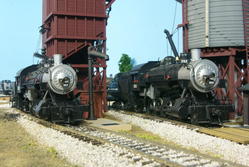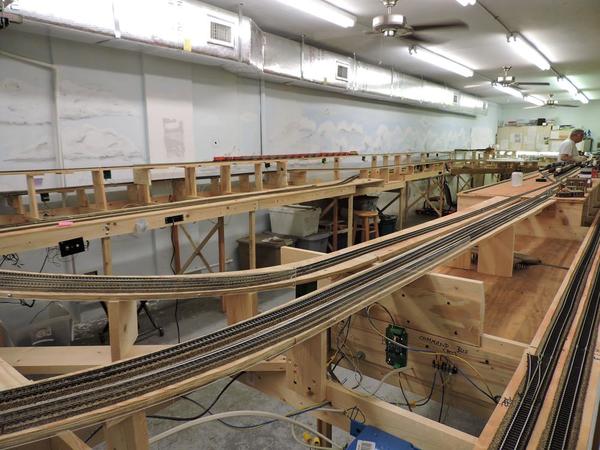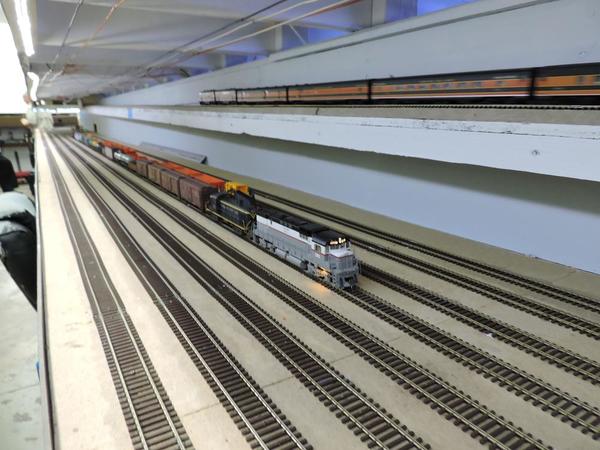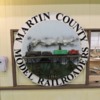Late to the conversation - my take on Tom's DC-VS. DCC initial post and some of the followup ones
For me the two major drivers for choosing DCC (or any digital control system) were:
Flexible Layout operation in a multi train environment: I ran a large DC layout (1400' of track, 6 cabs) for 20+ years. Attentive skilled operators could run the railroad, but invariably several times during an session someone would run into another operator's block. Digital control eliminated that issue - simplifying operation especially for visiting operators. An added benefit of digital control on a railroad with a helper district like mine is that adding and cutting off locomotives (even on the fly) is a piece of cake with independent control of locomotives on the same track. Radio linked cabs greatly facilitate operation by enhancing the association of the engineer with the locomotive. I should add that being able to use a radio cab anywhere on the railroad is a big help when working track or rolling stock performance issues out on the line.
Digital sound: I've found that even the most highly detailed and smooth running locomotive is lifeless compared to one equipped with digital sound (not blasted please). In my experience most operators run trains in a more prototypical manor (generally slower and smoother) with sound providing feedback to throttle changes. The best of the new digital sound decoders provide a wide selection diesel prime mover, horns, whistles, of whistles, etc that can be matched closely to the prototype the model is representing. For me a must have feature for steam locomotives is dynamic load sensing chuff. A drifting locomotive shouldn't sound like one accelerating a heavy freight from a stop.
Secondary reasons for choose DCC over DC include:
Simplified wiring -
Eliminats the need for block -cab selector switches (but does not eliminate or reduce the need for track feeders). (don't trust rail joiners for reliable electrical feeds in either DC or DCC) - over a span of years rail joiner electrical paths typically fail at embarrassing times or at inconvenient locations.
Provides for automated 2 rail reverse loop polarity matching (Y's and turntable too) using easy to wire devices.
Electronic devices available for digital control of turnouts and route selection (great for one touch routing in and out of multi-track staging yards)
DCC Decoder costs have declined while new features continue to be added. While DCS has evolved into a competent command control system for 2 rail model railroads, it has not kept up with the new features and does not offer a cost favorable option for aftermarket installation of DCS electronics in non-MTH locomotives. That said, if one has an existing investment in DCS and you plan on running a roster heavy with MTH locomotives it may make sense to stick with DCS. But for most folks starting out in O scale 2 rail or moving from DC I recommend going with an open market standards based DCC system so you'll not be captive to any one company for product availability, features , or pricing.
Surround Sound - Maybe desirable for Z or N scales where installing decoders is an issue - but for O scale where space isn't an issue to me it doesn't make sense as the sound isn't coming out of the locomotive. I've installed the speakers in my steam locomotives in the smoke box (pointing up the stack). As a matter of personal preference I've gone with smoke box mounted speakers, vice larger ones in the tender body. With O scale sized locomotives running in close proximity to the operators (walk around radio control) it is very apparent where the sound is emanating from - and tender sourced sound just doesn't seem right to me. Obviously a matter of personal taste with no right or wrong.
Snubbers: Filters installed at the far end of track bus to "clean up DCC wave forms. I have 3 power districts (3 boosters) with AWG 12 track bus runs over 120' long. In 8 years of trouble free DCC ops I haven't experienced control loss. If and when it does occur it is a simple matter to add a snubber to the end of the runs. For more on snubbers and other DCC info/tips check out Mark Gurries DCC web site.
Fast acting DCC power management (breakers) and Power Districts. Each of my 3 power districts are controlled by a DCC Specialties fast acting Power Shield. With 10 amps on the rails you need a very fast acting breaker to protect your equipment in the event of a short (like running into an open turnout). The Power Shield instantly responds to derailments/shorts and prevents meltdowns. It also self resets when the problem is cleared - no need to reboot the system. DCC Specialties also offers excellent auto reversers for reverse loop protection/operation. See this month's MR for a good write-up on DCC power management approaches and devices. Remember - you don't need an expensive 10 amp booster for each power district. Multiple power districts can be hung like the branches of a tree off a single booster, with each branch protected from shorts and over current by a device like a Power Shield. Early on I invested a digital ammeter (DCC Specialties RRampmeter) to monitor the varying current demands on the railroad. My observation is that I probably could scale back from three 10 amp boosters to two. What I wouldn't scale back is the number of power districts. You don't want a derailment in one part of the railroad suddenly shutting down power in other parts of the railroad. One of my 2017 projects is to split off my main yard and engine terminal into its own power district. It should be Something relatively easy to do as when I wired that part of the railroad I made provision for separating the yard track power bus from the main line track bus passing through the yard area.
Decoder current ratings - Not all O scale locomotives require 4 amp "O scale decoders". Most of my brass diesel fleet is powered by less expensive 1.8 amp QSI decoders. As Wes pointed out, with high efficiency motors/drive trains some locomotives can run nicely with 2 or even 1 amp decoders - a money saver. With modern decoder designs the decoder's software protects the hardware from burnout due to loading. SoundTraxx recommends using stall current vice continuous current draw when selecting their 1, 2 or 4 amp Tsunami2 decoders. To measure stall current I hold the drivers from turning when powering the locomotive up on the workbench test stand.




















